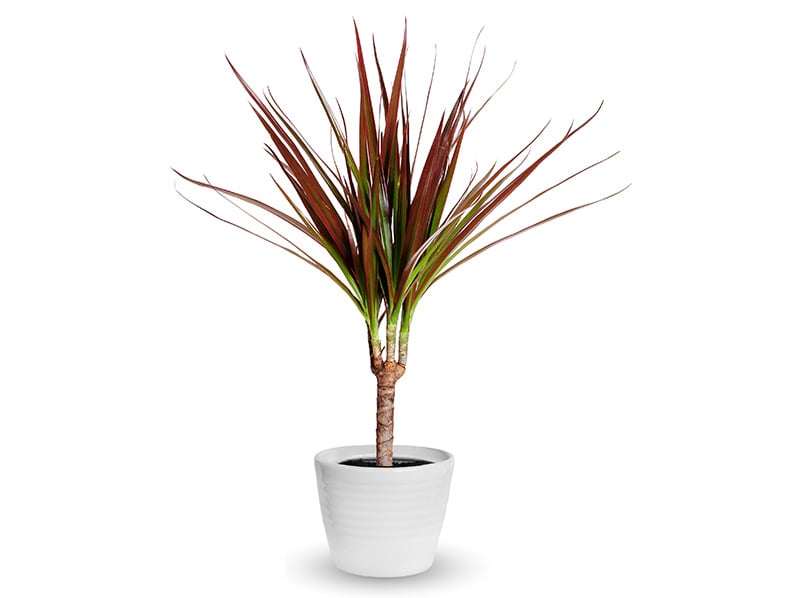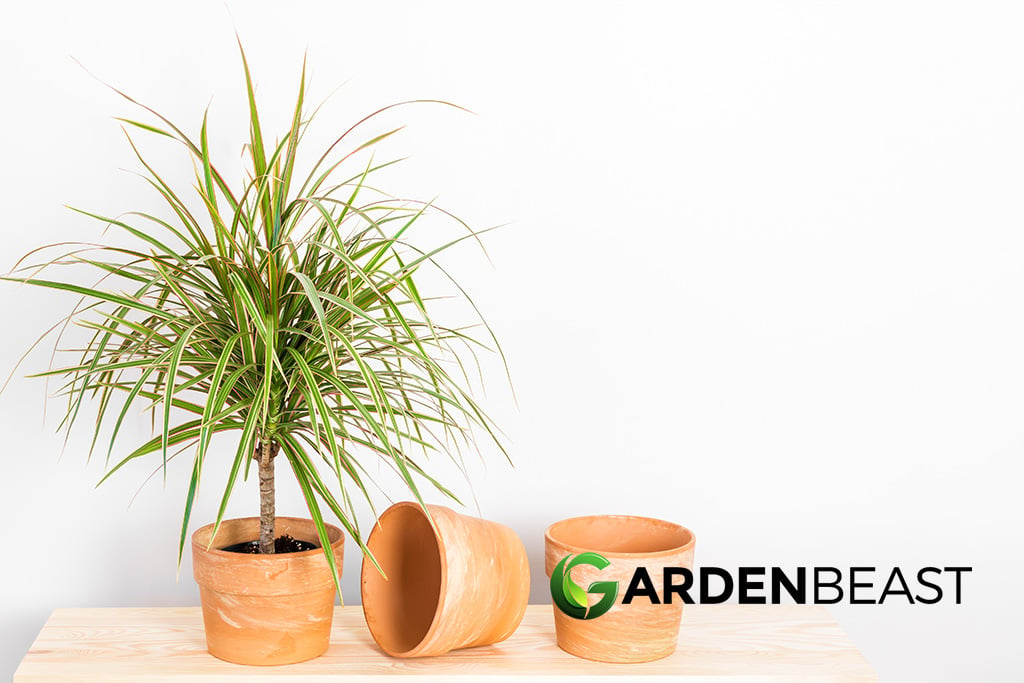Dracaena Marginata is an exotic evergreen plant, most commonly known as Madagascar Dragon Tree or Dragon Plant. The plant’s long leaves and thick trunk give it a palm-like appearance, but the Dragon Tree has no relation to the Palm Tree. In fact, it is more closely related to the lily.
The Madagascar Dragon Tree belongs to the Dracaena family, which includes over 120 species of succulent shrubs and trees. You can also find it classified in the Asparagaceae family, more specifically in the Nolinoideae subfamily.
As the name suggests, it is native to Madagascar, but it is also wildly spread in Mauritius. The Dragon Plant is one of the most resilient plants in its family, and the easiest one to grow indoors.
Watch Our Latest YouTube Video ...
About the Madagascar Dragon Tree
- The Dracaena Marginata is one of the most popular home plants since it is very easy to care for and its tropical appearance integrates well in modern environments.
- With proper care, it has a great lifespan, living up to a decade in a pot, and it has an even longer life expectancy outdoors.
- Dracaena is a Romanized form of a Greek noun. It roughly translates into a she-dragon. It is the impressive size of a wild Dragon Tree that has inspired its name.
- The Madagascar Dragon Tree is not susceptible to diseases, but scale, thrips, mealybugs, and spider mites can cause occasional problems. It is best to check the plant regularly and identify the pests before they damage the plant.
- This plant has great air-purifying properties. Not only does it tackle indoor pollution, but it is also a great defense against allergens. It is particularly useful for filtering benzene, lead, carbon dioxide, cigarette smoke, and several VOCs.
- The plant’s leaves are rich in antioxidants and they are sometimes used in traditional medicine for curing headaches and eye soreness.
- This plant is not toxic to humans, but it can be very dangerous for pets, especially cats and dogs. The leaves contain toxic alkyds which cause poisoning when chewed by pets. Poisoning symptoms include vomiting and excessive salivation.

Madagascar Dragon Tree Features: An Overview
- The Dracaena Marginata has grey stems with arching sword-like green leaves with red edges.
- The linear leaves are about 30-90 cm long with a maximum width of 7 cm.
- Mature plants are usually between 2 and 5 meters tall, with a diameter of 1 or 2 meters.
- Outdoor varieties bloom in spring. They have fragrant white flowers that develop into circular yellow berries.
- The plant’s native environment is highly humid, but this doesn’t stop the Dragon Tree from surviving in dryer environments. The lower humidity found in most indoor environments will hinder its growth. However, few people want a 5-meter plant indoors, so there is no need to satisfy its native humidity needs. The plant is also unlikely to bloom indoors due to the dry air.
- The most common varieties are the Dracaena Marginata Tricolor (featuring a beige center with green leaves and red margins), Dracaena Marginata Colorama (vibrant pink leaves with white and green stripes), and Dracaena Marginata Bicolor (green and white leaves, with dark pink margins). Hybrid crosses are also common between this plant’s varieties.

Growing the Madagascar Dragon Tree
Despite its tropical nature, this plant doesn’t have sophisticated environmental needs. It grows well in average room environments, but it can survive in temperatures as low as 15°C. However, a lower temperature will cause leaf drops.
The plant prefers regular watering, but it is also resilient in dry soil. Nonetheless, overwatering can cause root decay. Ideally, the plant should be placed in well-lit environments, but it can also grow well in partial shade.
Indoor plants do well in containers with good drainage. You can enhance the drainage by putting a layer of pebbles at the bottom of your pot. As far as the soil goes, you can’t go wrong with a mixture of clay, sand, and silt.
Repotting will be necessary every 2 or 3 years. The plant grows during spring and summer, and you can give it a boost of nutrients during these seasons. Use a liquid or a slow-release fertilizer. It is very sensitive to fertilizers, and a strong mix could burn it. You can also use fermented weed tea if you prefer natural fertilizer. The soil should be well moist before fertilizing the plant. Keep in mind to never fertilize it in the winter.

If you live in a tropical area, you can grow the Dragon tree outdoors. In rich soil, it will grow very tall and strong, provided that you protect it from strong winds. You will need to prune to manage its size. However, the plant has a slow growth rate, so pruning won’t be a burden. Ideally, you should give it a more vigorous pruning before a rainy season to ensure the growth of new shoots.
If you want to move your indoor plant outdoors, you should acclimatize it first. Do this by placing the pot for a few weeks in the area where you plan to plant the tree. Make sure your garden soil is rich in nutrients and it has good draining properties.
Despite its natural size, this plant can also be grown as a bonsai tree. It has a special capacity to fuse stems that are too close into a single thick trunk, which is ideal for bonsais. You can also wire branches together and manipulate their growth into the desired shape.
For bonsai Dragon Trees, start by keeping the plant in bright sunlight to encourage its growth in different directions. Once it reaches the right size, move it to a low- light area to manage its size.
Watering the Madagascar Dragon Tree
The plant’s natural environment includes regular droughts followed by floods, so it is no wonder that the Dragon Tree can survive with irregular watering. Ideally, you should water the plant once a week in the summertime, and once every two or three weeks in the winter. Decrease the watering frequency gradually as the season changes.
Watering needs depend greatly upon the amount of light that the plant gets. The soil should be kept slightly moist, but always allow the top two cm to dry before watering again. Overwatering will cause yellow leaves or dark leaf tips. Misting the leaves will encourage the plant’s growth.
Tap water should work well for watering this plant. However, if your tap water has too much fluoride, it can scorch the leaves. If possible, it is always safer to use distilled water or rainwater.
- Dracaena Marginata (Madagascar Dragon Tree) has a gorgeous head of narrow, bright green leaves edged with red or pink stripes; easy to grow, it's considered one of the most popular houseplants around. Delivers in a plant pot already decorated to match your style. Basket is lined with a plastic liner to help water from draining through. Made of natural seagrass, baskets may bend slightly during transit however will bounce back to shape over time.
- Potted in a decor plant pot. Water when soil feels dry; don't allow to sit in water, drain any excess water. Madagascar dragon tree does best in a bright spot, but will tolerate low-light conditions so you can grow it practically anywhere.
- Plant height at dispatch measures approximately 44-inches tall, measured from bottom of the pot to top of the plant. Grow against a blank wall, to provide privacy in front of a window, or at the end of a sofa or chair as it ages and becomes tree like.
- Nasa Proven studies: NASA studies show plants are earth's natural air-purifiers.
- Arrives fast from our farm to your home. Authentic Costa Farms brand plants are in black nursery-grower pots with premium soil, slow release fertilizer and have the Costa Farms logo on the pots.
- 🌿 Striking Red-Edged Leaves for Visual Appeal: The Madagascar Dragon Tree features stunning slender leaves with vibrant green centers and distinctive reddish-purple edges, offering a dramatic and colorful accent to any indoor setting. Its unique foliage brings an exotic flair to your decor.
- 🍃 Natural Air Purifier for Healthier Living Spaces: This tree is not just decorative; it actively improves air quality. It removes harmful toxins from the air, creating a healthier and more refreshing environment in your home or office. Enjoy cleaner air along with its aesthetic beauty.
- 🌞 Adaptable to a Range of Light Conditions: The Dragon Tree thrives in various light settings, from low to bright indirect sunlight. Its versatility in light adaptability makes it an ideal plant for different indoor spaces, ensuring growth and vibrancy anywhere it's placed.
- 🌱 Easy Care for Busy Lifestyles: Specifically suited for those with a busy schedule, this tree requires minimal watering and upkeep. Its low maintenance nature means it's perfect for individuals who want greenery in their lives without the hassle of constant care.
- 🌼 Elegant and Sophisticated Indoor Tree: Perfect for enhancing the ambiance of homes and offices, the Madagascar Dragon Tree adds a touch of sophistication and elegance. Its tall, upright growth and striking leaves make it a focal point in any room, elevating the overall decor.
Last update on 2024-02-08 / Affiliate links / Images from Amazon Product Advertising API
Propagating the Madagascar Dragon Tree
The dragon plant can be propagated by seed, through semi-ripe cuttings or hardwood cuttings. Since seed propagation is time-consuming and requires a lot of care, most people opt for cuttings.
Propagation through wood cuttings is very simple, and due to the plant’s resilience, the propagation has a high degree of success. Since the stems of mature Dragon Plants are quite thick, make sure to use a good pair of garden scissors to cut off a branch.
Hardwood cuttings should be about 70-90 cm long. The cleaner the cut is, the easier it will be for it to catch roots. Rip off some of the leaves so that the new plant won’t be stressed to provide nutrients to a rich set of leaves. Ideally, you should have a maximum of 10 leaves.
To give the new plant a good start, you can dip the cut end into a rooting hormone. Plant your hardwood cutting into a mixture of compost and sand. You should plant it as close to the bottom as possible, without it touching the bottom. Stake the new plant using a pole that is three quarters the size of your cutting. Place the support stake in a slightly angled position and tie the cutting to it to give it stability. Keep the new plant in partial shade for about 6 months before moving it outdoors or in a new pot.
If you want to propagate through semi-ripe cuttings, make sure to include a couple of nodes in your cutting. Place the cutting in water, making sure that the nodes are well immersed. Keep the cuttings in water in a well-lit area for a few weeks until it develops roots about 2-3 cm long.
In Conclusion
As opposed to most tropical plants that tend to be high maintenance, the Madagascar Dragon Tree is very resilient and easy to care for. Basic plant care will guarantee many years of rich luscious foliage.
Due to its low maintenance, the Dragon Plant is suitable not only for offices but also for the homes of beginner gardeners. The plant has an exotic aesthetic that looks great in a modern, contemporary, or a Zen interior design. Moreover, its great air-purifying properties make it ideal for any city home. Last but not least, if you are lucky enough to own a home in a tropical environment, a Madagascar dragon tree will be the focal point of your garden.



